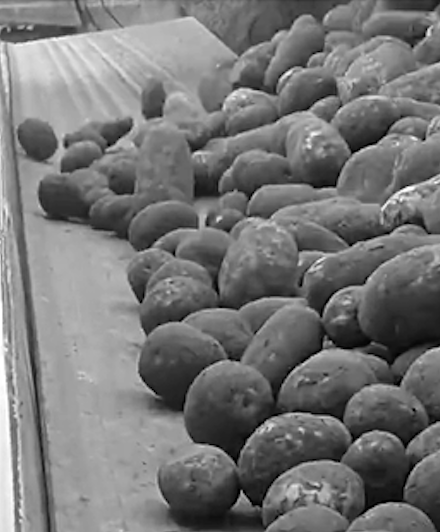It’s no secret that using the wrong component parts can lead to challenges with conveyor systems, resulting in downtime and backups that can negatively impact the potato storing process, derailing an already time-sensitive operation.
It’s also no secret that potatoes are a fickle crop. Temperature and weather sensitivity, combined with a short harvest and storage window, makes a smooth-running operation even more important for potato growers than it is for producers of other crop types.
The intricacies of conveyor belting, however, which play an important role in a seamless storage process, are much lesser known and understood. Knowing how to pinpoint and troubleshoot complications caused by conveyor belting — or better yet, avoid them altogether — can make the difference between a smooth harvest and storing process and one that is fraught with complications and delays.

In the thick of a past season, I witnessed a potato storage operation that had one central hopper and four storage barns. There were 15 to 20 semi-trucks in line dumping potatoes into the hopper via a conveyor system that was set up on a 90-degree angle, which then fed onto five to 10 different conveyors leading to the barn they were filling.
As the belt was loaded, the force of the potatoes pushed the product towards the edge of the conveyor. On this specific conveyor system, the belt that was being used was flat (no pattern) and lower in overall gauge. As a result, the belt continually buckled, and smaller potatoes worked their way under the belt on the opposite side from loading.
If this issue arises and is not caught in time, when that fold in the belt reaches the pulley, it will put stress on the belt splice that can cause significant damage or failure to the conveyor system and halt the entire operation. During the specific harvest that I witnessed, the operation had to be shut down to resplice the belt before they could resume. What started with several trucks in line waiting to unload resulted in a four-hour stall and more than 30 trucks in queue.
It might be instinctual to think that a thicker belt would be less likely to roll over and would therefore help avoid this issue. However, in this instance, the best belt option is one that is a similar thickness to what is already being used, but with more transverse rigidity, which will prevent the belt from folding over. A cross rigid belt will remain flat and even on both sides of the conveyor system. This will help prevent potatoes from getting stuck under the belt and, therefore, prevent unnecessary downtime and backups in the entire storage process.
Belt tension also plays a key role in the performance of a conveyor system. Each conveyor belt has an optimal load rating or operating tension that will allow the belt and conveyor to operate at peak performance. Having too little tension on the belt can also lead to the belt “walking” up the side of the conveyor, resulting in belt failure and conveyor downtime. Too much tension will put excess load on the splice, leading to potential hook retention and splice failure issues. Understanding how to achieve and maintain the correct operating tension as recommended by the belt manufacturer will pay off in the long run with reduced downtime and a more efficient conveyor system.

Installing a conveyor belt that offers more rigidity and a transverse strength, and understanding and properly utilizing belt tension, can go a long way toward improving the potato harvest and storage process. If there is one thing you do to enhance your potato storing operation after your recent harvest, we recommend reviewing your current belts, exploring options for a cross rigid belt, and confirming that you’re using belt tensions properly. The right belt can prevent stressful and unnecessary interruptions increasing profitability and your bottom line.
— By Mike Schroeder, a product specialist at WCCO Belting.







